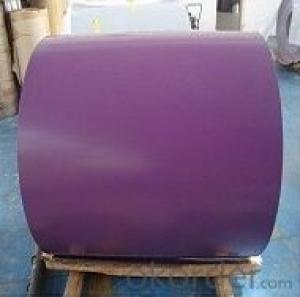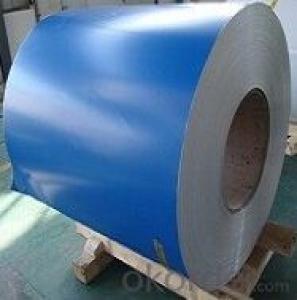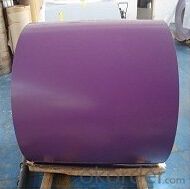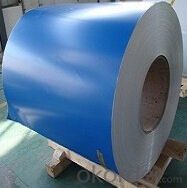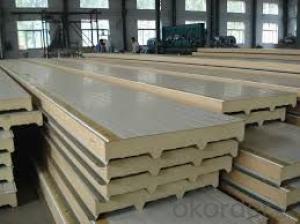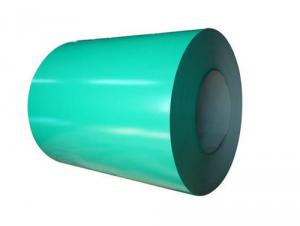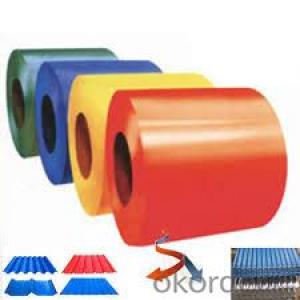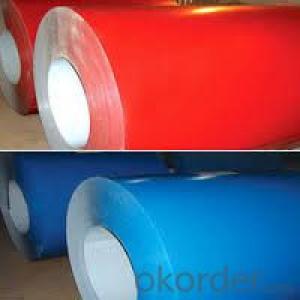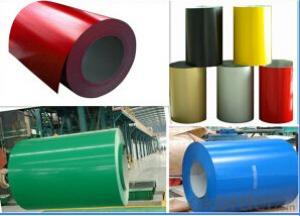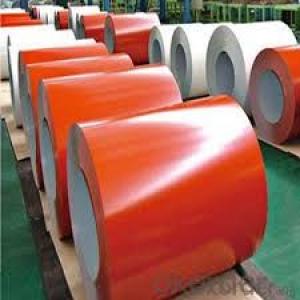Prepainted Galvanized Steel Coil, PPGI, PPGL Coil, Color Coated Coil
- Loading Port:
- Tianjin
- Payment Terms:
- TT OR LC
- Min Order Qty:
- 25 m.t.
- Supply Capability:
- 10000 m.t./month
OKorder Service Pledge
OKorder Financial Service
You Might Also Like
Description.
Model NO.:0.16MM-1.0MM*1250MM OR UNDER
Type:Steel Plate
Technique:Cold Rolled
Certification:ISO
Standard:GB, JIS
Stock:Stock
Surface Treatment:Galvanized
Special Use:Wear Resistant Steel
Application:Ship Plate, Boiler Plate, Container Plate, Construction
Thickness:0.17--1.0mm
Width:700-1250mm
Zinc Coating:Z40-Z275g/Psm
Grade:SGCC
Export Markets:Global
Additional Info.
Packing:Containers
Standard:GB
Origin:China(Mainland)
HS Code:7210701000
Production Capacity:300, 000 Tons Per Year
Product Description
Specifications
1.Color: RAL color or according the sample
2.Type of coating structure: 2/1 or 2/2 coating, or customized
3.prepainted gi steel coil .
4.Excellent waterproof/fire proof
5.Low cost,good price,long life
6.Large,stabe supply
7.RAL6019
Features
1. High corrosion, rust, acid resistance
2. Formability and decoration
3. Excellent work ability
Application
1. Pre-galvanized steel tubes and pipes.
2. Galvanized steel channels and profiles.
3. Armoring cable.
4. Construction,the manufacturing of cars, ships, containers and household electric appliances, other industrial use.
Our Advantages
1. High quality products:Products comply with the standard of ISO9001 .
2. High automation:It is controlled by PC system and equipped with frequency conversion.
3. Low production cost: Advanced technology of removing iron keep the content of 2 valent iron under 0.6 g/L and reduce zinc consumption 5-10kg/ton.The gas is the fuel.
4. Long service life of zinc pot: The heating is from reflective wall and well-distributed.It can reduce corrosive rate.
5. Installation with instruction of experienced engineers
6. Easy to assemble and dismantle
7. Eco-friendly material: can be used for several times and can be recycled
8. Shorter construction period, longer using time
9. High strength and stiffness, high weight bearing.
10.Sound insulation and heat insulation; antisepsis and damp proofing; waterproof and aseismatic.
| PPGI/PPGL Color Coated Steel Coils | |
| Base materials | SGCC |
| Standard | JIS GB |
| Thickness(mm) | 0.14-0.8 |
| Width(mm) | 650-1250 |
| Coil weight(MT) | 3-8 |
| Zinc coating(g/m2) | 40-60 |
| Top painting(um) | 15 |
| Black painting(um) | 7 |
| Paint type | Polyester/Matt polyester |
| Surface treatment | color coated |
| Tolerance(mm) | thk: +/-0.02mm wid: +/-2mm |
| Coil ID(mm) | 508/610 |
| Color | As RAL colors or your request |
| End use | Roll froming |
| Package | Export Standard Package or as Request |
FAQ
1.What's your MOQ?
25MT, it is for one container.
2.Do you have QC teams?
Yeah, sure, our QC team is very important, they will keep the quality control for our products.
3. What's your normal delivery time?
Our delivery time about 10-20days for standard sizes, if you have other requirements like hardness and width ,it is about 20-40days. But don't worry ,we also try our best for the delivery time ,because time longer and our cost is higher.
4.Are the products tested before shipping?
Yes, all of our PPGI and GI was qualified before shipping. We test every batch every day
- Q: what happened to all the steel beams from the WTC buildings? did anyone do any forensic analysisof any of the steel?
- some of the steel was recycled into a warship. I am not sure at what you are trying to get at with the forensic analysis of the steel. There is no conspiracy involving the towers outside of planes crashing into them despite what a lunatic fringe want you to think.
- Q: What is the shelf life of a steel coil?
- The duration for which a steel coil remains usable depends on several factors, including the type of steel, storage conditions, and protective measures implemented. Steel coils can generally be stored for a few months to several years. If a steel coil is stored appropriately in a controlled environment with suitable temperature, humidity, and ventilation, its lifespan can be extended. Moreover, if the coil is coated with protective substances like oil or anti-corrosion coatings, its shelf life can be further prolonged. However, if a steel coil is exposed to unfavorable storage conditions such as high humidity, extreme temperatures, or corrosive substances, its shelf life can significantly decrease. Rust and corrosion can occur due to exposure to moisture and oxygen, leading to a decline in quality and structural integrity. To maximize the shelf life of a steel coil, it is crucial to store it in a well-ventilated, dry area, away from direct sunlight and corrosive substances. Regular inspections and maintenance, including cleaning and reapplication of protective coatings, can also help preserve the coil's quality. Ultimately, it is essential to consult the manufacturer or supplier of the steel coil for specific recommendations regarding shelf life, as different types of steel may have varying levels of durability and specific storage requirements.
- Q: i mean cor ten steel( rusted)
- If the steel is true Cor Ten steel, it does not require waxing. Cor Ten is a steel designed to rust slowly over time ... then the rust acts as a natural barrier to prevent further rust. Check out the United States Steel building in downtown Pittsburgh, PA ... its nickname is The Rusty Nail.
- Q: How are steel coils protected against moisture and humidity?
- Steel coils are protected against moisture and humidity through a variety of methods. One common method is the application of a protective coating on the surface of the steel. This coating acts as a barrier, preventing moisture from coming into direct contact with the steel surface. Coatings can be made of various materials such as paint, zinc, or other corrosion-resistant substances. In addition to coatings, steel coils are often wrapped in a moisture-resistant material such as plastic or waxed paper. This wrapping provides an extra layer of protection, preventing moisture from seeping into the coils during storage or transportation. Furthermore, steel coils are typically stored in a controlled environment with controlled humidity levels. This helps to minimize the chances of moisture condensation on the surface of the coils. Storage facilities may also utilize dehumidifiers or other moisture control measures to maintain optimal conditions. Lastly, proper handling and transportation practices are crucial in ensuring the protection of steel coils against moisture and humidity. Special care is taken to avoid exposing the coils to rain or excessive humidity during loading, unloading, and transportation processes. By employing these various protective measures, steel coils can be effectively safeguarded against moisture and humidity, reducing the risk of corrosion and maintaining their quality and integrity.
- Q: What are the different methods of surface inspection for steel coils?
- Some of the different methods of surface inspection for steel coils include visual inspection, magnetic particle inspection, dye penetrant inspection, eddy current inspection, and ultrasonic inspection.
- Q: How do steel coils contribute to the oil and gas industry?
- Steel coils are an essential component in the oil and gas industry as they are used to manufacture various equipment and structures like pipelines, storage tanks, and drilling rigs. These coils provide the necessary strength, durability, and resistance to corrosion required for the harsh operating conditions in the industry. Additionally, steel coils are crucial in the transportation of oil and gas as they are used in the construction of tankers and pipelines, ensuring the safe and efficient movement of these valuable resources.
- Q: They say it's some six times stronger than steel. need some explanation.
- Lol I dont know where you heard that, there probably saying for small insects like for instence a small instect in a spider web is like us( humans ) in steel but no I could break through a web with my soft hair or finger, like not an ant because there extremely strong but like a flea
- Q: How are steel coils used in the manufacturing of flooring materials?
- Steel coils are used in the manufacturing of flooring materials by being formed into sheets or strips and then processed through various techniques such as cutting, bending, and shaping to create the desired flooring products. The steel coils provide strength, durability, and stability to the flooring materials, ensuring long-lasting and reliable flooring solutions.
- Q: in broken steel can you to missions and get things like the dog, you previously didnt do/get in fallout 3?
- Yes, with Broken Steel there is no end to the game. You survive the main quest where you would die in the original game and may go on to explore the wasteland forever.
- Q: What are the common methods of welding steel coils?
- The common methods of welding steel coils include arc welding, resistance welding, and laser welding.
Send your message to us
Prepainted Galvanized Steel Coil, PPGI, PPGL Coil, Color Coated Coil
- Loading Port:
- Tianjin
- Payment Terms:
- TT OR LC
- Min Order Qty:
- 25 m.t.
- Supply Capability:
- 10000 m.t./month
OKorder Service Pledge
OKorder Financial Service
Similar products
Hot products
Hot Searches
Related keywords
